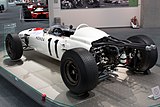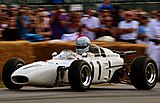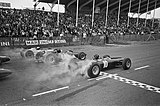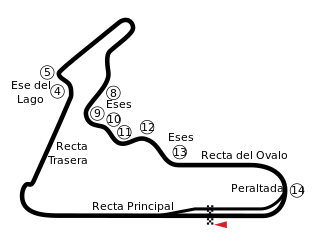
The 1965 Mexican Grand Prix was a Formula One motor race held at Ciudad Deportiva Magdalena Mixhuca in Mexico City on October 24, 1965. It was race 10 of 10 in both the 1965 World Championship of Drivers and the 1965 International Cup for Formula One Manufacturers. The race was won by Richie Ginther, who took his first and only victory, first for the Honda team and, excluding the Indianapolis 500, first win for the non-European team, after leading for the entire race. The Brabham-Climax of Dan Gurney finished the race second and the Lotus-Climax of Mike Spence completed the podium.

The 1966 Italian Grand Prix was a Formula One motor race held at Monza on 4 September 1966. It was race 7 of 9 in both the 1966 World Championship of Drivers and the 1966 International Cup for Formula One Manufacturers. The race was the 36th Italian Grand Prix and the 32nd to be held at Monza. The race was held over 68 laps of the five kilometre circuit for a race distance of 391 kilometres.
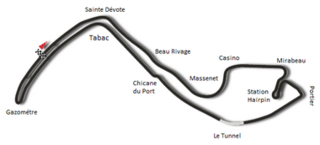
The 1967 Monaco Grand Prix was a Formula One motor race held at Monaco on May 7, 1967. It was race 2 of 11 in both the 1967 World Championship of Drivers and the 1967 International Cup for Formula One Manufacturers, albeit four months after Pedro Rodríguez's unexpected victory at Kyalami. The 100-lap race was won by Brabham driver Denny Hulme after he started from fourth position. Graham Hill finished second for the Lotus team and Ferrari driver Chris Amon came in third.

The 1989 FIA Formula One World Championship was the 43rd season of FIA Formula One motor racing. It began on 26 March and ended on 5 November. Alain Prost won his third Drivers' Championship, and McLaren won the Constructors' Championship.
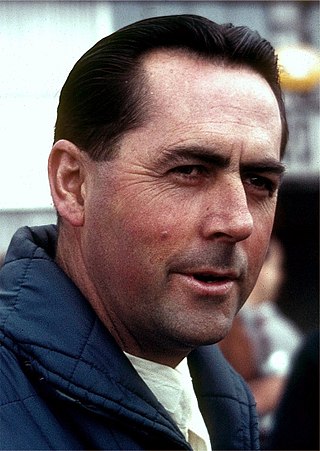
The 1966 Formula One season was the 20th season of FIA Formula One motor racing. It featured the 17th World Championship of Drivers, the 9th International Cup for F1 Manufacturers, and four non-championship races open to Formula One cars. The World Championship was contested over nine races between 22 May and 23 October 1966.

The 1965 Formula One season was the 19th season of FIA Formula One racing. It featured the 16th World Championship of Drivers, the 8th International Cup for F1 Manufacturers, and seven non-championship races open to Formula One cars. The World Championship was contested over ten races between 1 January and 24 October 1965.

The 1964 Formula One season was the 18th season of FIA Formula One motor racing. It featured the 15th World Championship of Drivers, the 7th International Cup for F1 Manufacturers, and eight non-championship races open to Formula One cars. The World Championship was contested over ten races between 10 May and 25 October 1964.

Paul Richard "Richie" Ginther was a racecar driver from the United States. During a varied career, the 1965 Mexican Grand Prix saw Ginther take Honda's first Grand Prix victory, a victory which would also prove to be Ginther's only win in Formula One. Ginther competed in 54 World Championship Formula One Grand Prix races and numerous other non-Championship F1 events.
The Japanese automobile manufacturer Honda has participated in Formula One, as an engine manufacturer and team owner, for various periods since 1964. Honda's involvement in Formula One began as a full team and engine entry in the 1964 season, and in 1965 they achieved their first victory at the Mexican Grand Prix. After further success with John Surtees, Honda withdrew at the end of the 1968 season due to difficulties selling road cars in the United States and Honda driver Jo Schlesser's fatal accident.

The McLaren MP4/6 is a Formula One racing car designed by McLaren's Neil Oatley, Matthew Jeffreys, David North, David Neilson, Bob Bell and Mike Gascoyne; powered by the Honda RA121E V12 engine for use in the 1991 Formula One season, with the engine's design and development led by Osamu Goto. It was driven by reigning World Champion, Brazilian Ayrton Senna, and Austria's Gerhard Berger. Ayrton Senna would win his third World Championship in the MP4/6. The MP4/6 was notable for being the last F1 car to win the championship with a manual gearbox and the only F1 car powered by a V12 engine to do so.

The Honda RA300 was a Formula One racing car produced by Honda Racing, and introduced towards the end of the 1967 Formula One season. It retained the same V12 engine as the preceding RA273 car, but the chassis was designed by Lola's Eric Broadley and based on a previous Lola Indianapolis 500 car, the T90. Internally, Lola designated the RA300 the T130. This collaboration resulted in the machine quickly being dubbed the "Hondola" by the motorsports press.
This article gives an outline of Formula One engines, also called Formula One power units since the hybrid era starting in 2014. Since its inception in 1947, Formula One has used a variety of engine regulations. Formulae limiting engine capacity had been used in Grand Prix racing on a regular basis since after World War I. The engine formulae are divided according to era.

The Honda RA271 was Honda's first Formula One racing car to enter a race. The chief engineer on the project was Yoshio Nakamura, with Tadashi Kume in charge of engine development. It was driven in three races during 1964 by American driver Ronnie Bucknum.
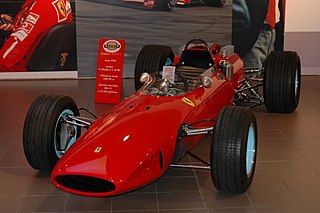
The Ferrari 158 was a Formula One racing car made by Ferrari in 1964 as a successor to the V6-powered Ferrari 156 F1.

The Ferrari F1/87 is a Formula One racing car used by the Ferrari team during the 1987 Formula One season. The car was driven by Michele Alboreto and Gerhard Berger and replaced the Ferrari F1/86 used in 1986.
Honda has been competing in a variety of racing series through the years, including Formula One, IndyCar, touring car racing, sports car racing and MotoGP. Currently they are involved in Formula One, MotoGP, Super GT, Super Formula, IndyCar, IMSA, BTCC, TC2000, Formula 3, Formula 4, off-road, WSBK, EWC, MXGP, TrialGP and various different GT3 and TCR series. All of Honda's motorsport activities are managed by Honda Racing Corporation (HRC).

The Ferrari 412 S was a unique sports racing car produced by Ferrari in 1958. The 412 S combined Ferrari's most powerful V12 engine to date with a one-off experimental racing chassis. It was also incorrectly called as the 412 MI due to being built around an engine from the 500 Miles of Monza racer. The car was created specifically for John von Neumann to take on the American racing cars Scarabs in SCCA racing. Its famed drivers included Phil Hill and Richie Ginther.

Honda has made a number of naturally-aspirated V12 engines designed for Formula One motor racing; starting with the 1.5-litre RA271E engine in 1964, and ending with the 3.0-litre RA273E in 1968. This would be followed by a 21-year hiatus, until Honda reintroduced the new 3.5-litre RA121E in 1991. The RA121E would go down as the last V12 engine to win a Formula One World Championship. Honda's last-ever V12 engine, the RA122E/B, raced in 1992.

The Lamborghini LE3512 was a naturally-aspirated V12 motor racing engine, designed and developed by Lamborghini, to compete in Formula One. The engine was raced between 1989 and 1993.

Ferrari has made a number of V12 racing engines designed for Formula One; made between 1950 and 1995. Some derived engines were also used in various Ferrari sports prototype race cars and production road cars.



